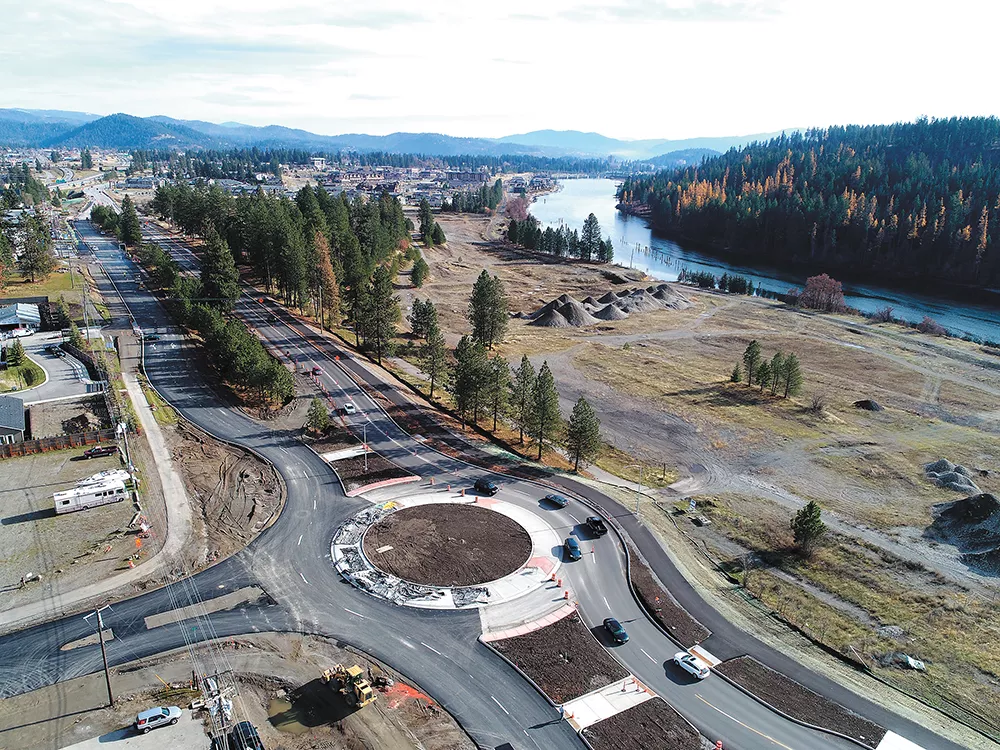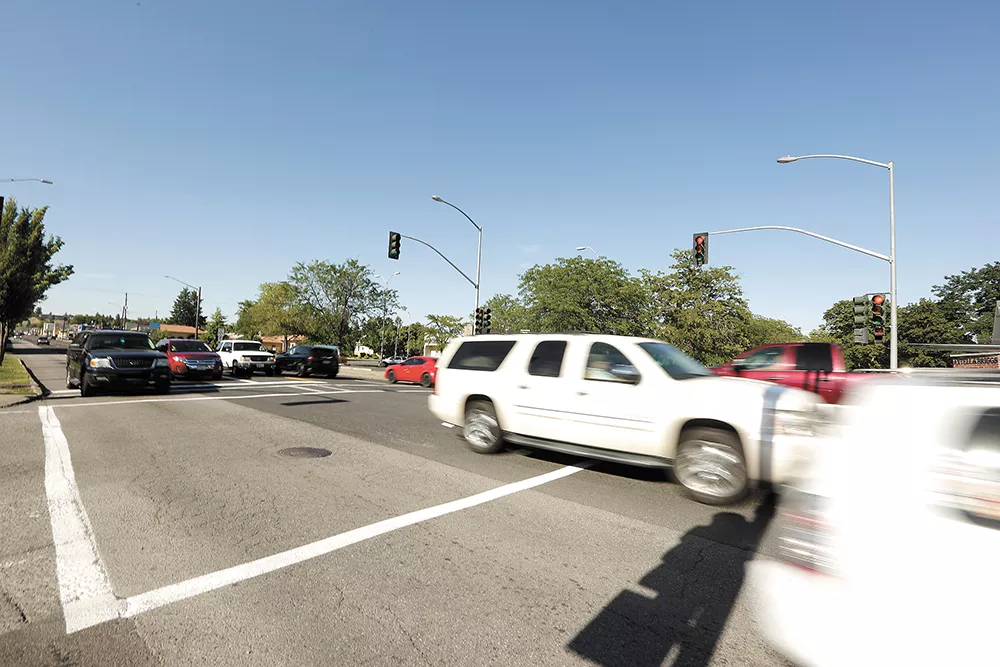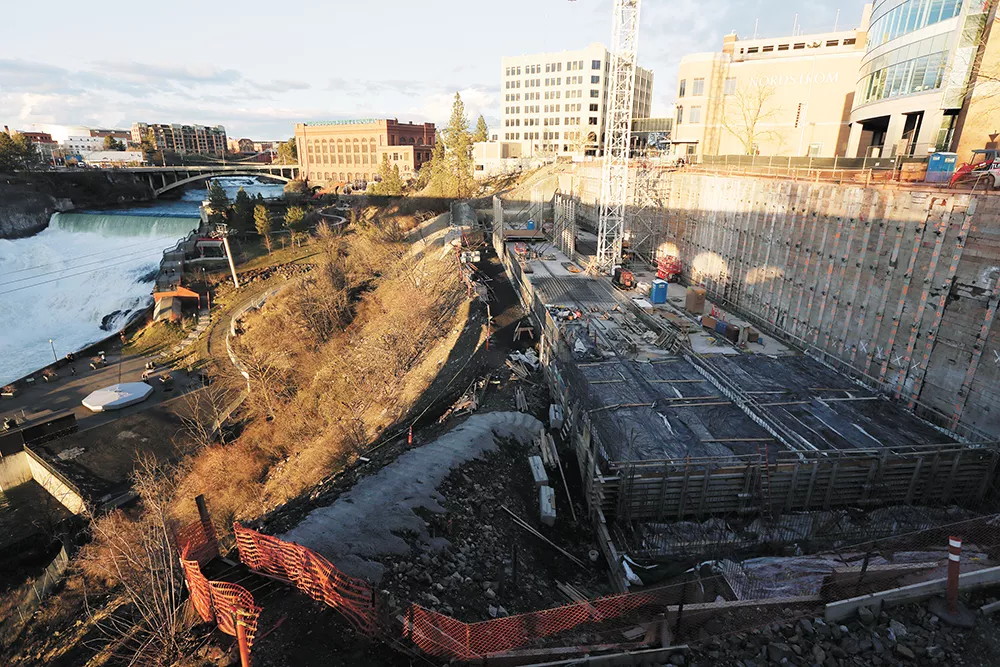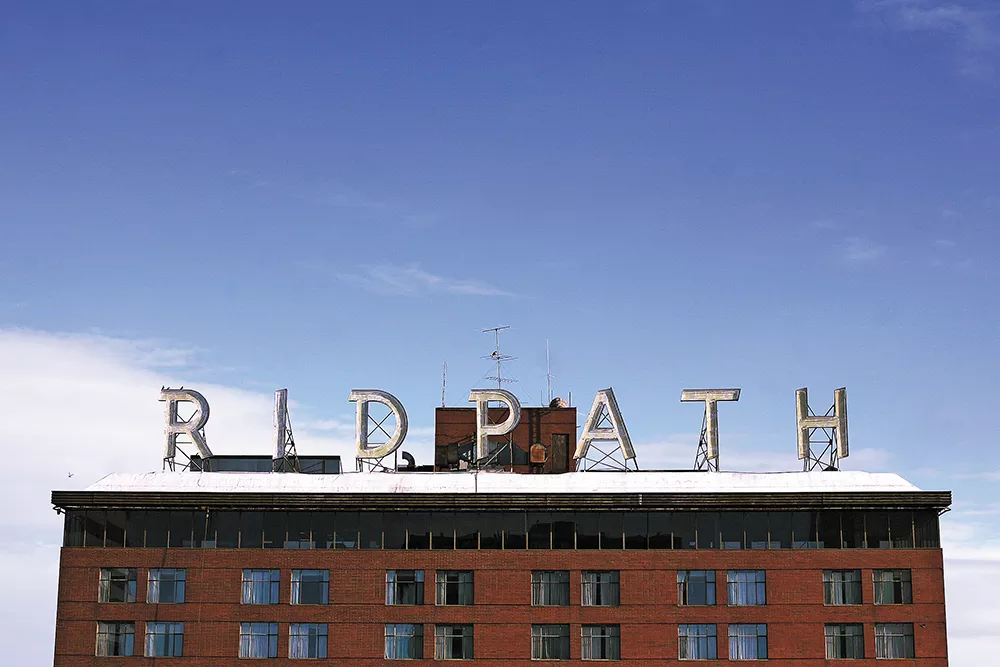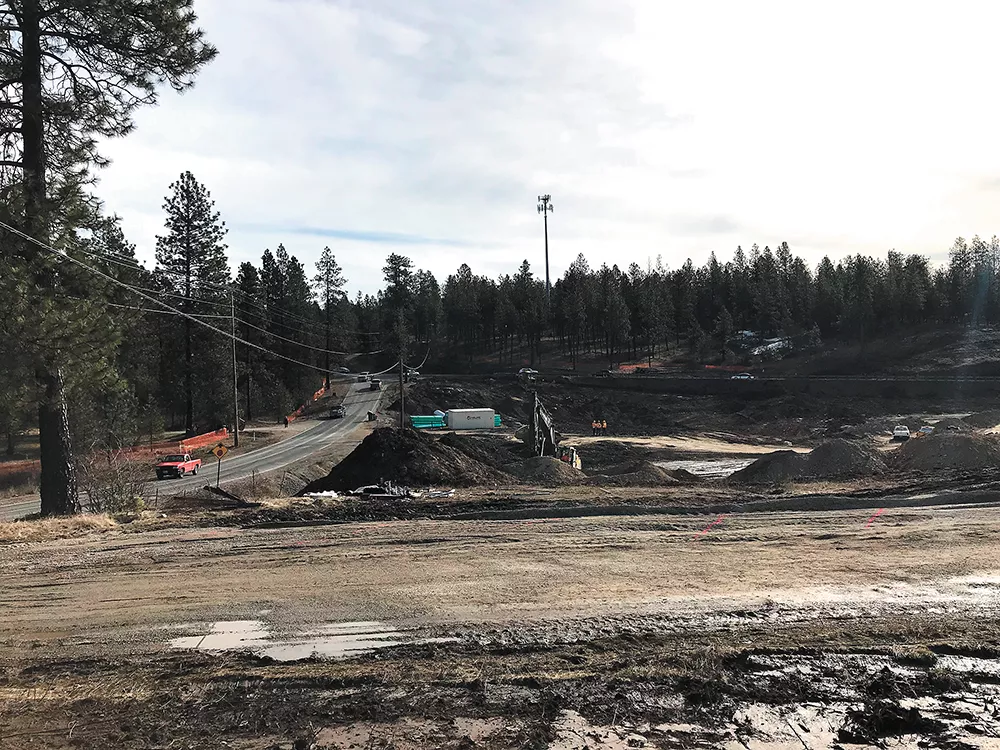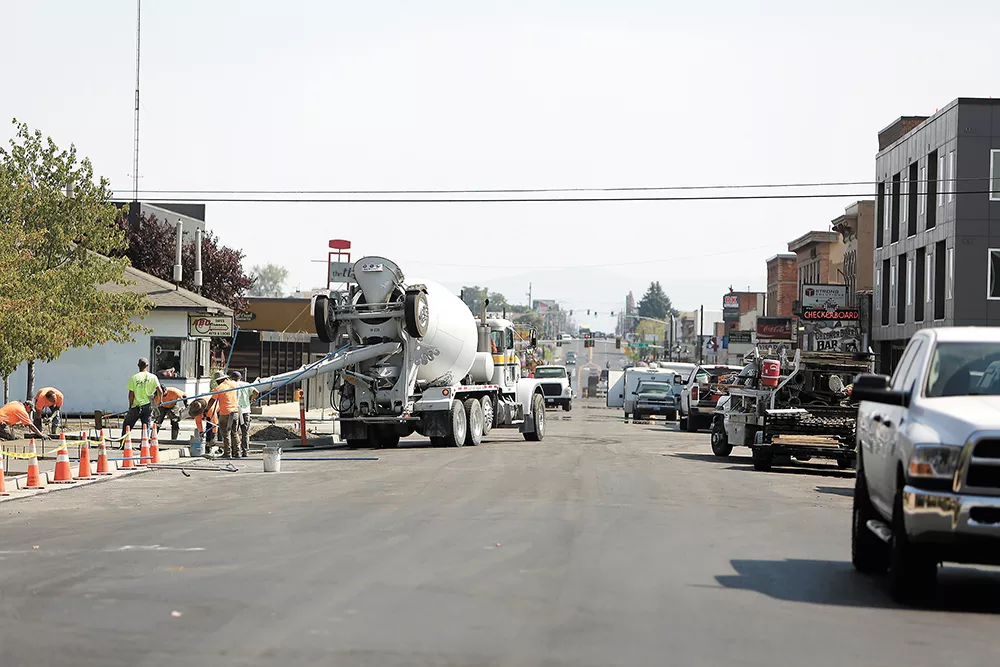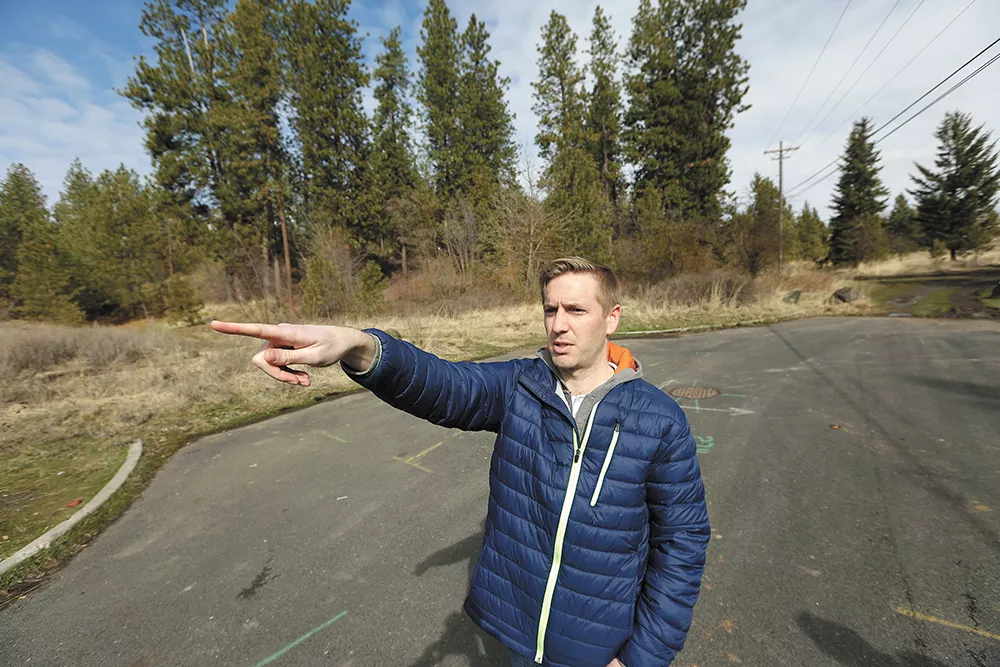
More than 75 neighbors are packed into the Southside Senior Activity and Community Center — far more than the seating allows. They shift impatiently as the Lincoln Heights Neighborhood Council discusses neighborhood cleanups, police ride-alongs and Community Development Block Grants.
Finally, Jeff Overholser, a Lincoln Heights neighbor crossing his arms in a bright green T-shirt in the back, jumps in.
"When you guys are done with these topics, can I just ask this question? How in the hell can we not have this thing, that we're here for, built in this neighborhood? Why can't they go out in the Palouse?" Overholser says, as other neighbors begin to murmur in agreement. "I mean, really? I mean, I know 'progress.' But let's get down to it, this is going to destroy this neighborhood."
The "thing" Overholser is referring to is Greenstone's "Garden District" proposal. Eight years earlier, the developer had turned vast swaths of railroad land near downtown Spokane into Kendall Yards, one of the biggest urban infill developments in the city.
Now, it's looking to do the same on a property a third of the size: Turn the 25 acres of vacant woods southwest of 29th and Southeast Boulevard into an urban mixed-use development, with 233 residential units and 70,000 square feet of office, retail and commercial buildings.
In isolation, it's exactly the sort of walkable, diverse project the city's 2015 Comprehensive Plan envisioned when it described the "best patterns of urban development — infill and mixed-use development."
But the same plan also calls for neighborhoods to be protected from incompatible uses. A representative of Greenstone leans quietly against a wall at the council meeting, listening as, one by one, neighbors lay out arguments against the development. That it would make traffic on Crestline Street a horror show. That it would pack more students into an already overflowing Hamblen Elementary. That multifamily complexes would bring more crime. That it would irrevocably change the personality and ambiance of the neighborhood.
As one neighbor begins listing off all the wildlife in the vacant lot — quail, skunks, moose — a chorus of other neighbors joins in, calling out other animals they worry the development would force off the property.
"They're trying to put so much in such a tiny spot, in such a fine neighborhood," Overholser says. "And it doesn't make sense to me."
And that's the dilemma the city has been wrestling with for years: Leaders claim to want more dense, infill development. But what do they do when neighbors are standing in their way?

UP OR OUT
At a forum about homelessness last year, City Council President Ben Stuckart laid out Spokane's housing crisis with stark numbers: Spokane needs 11,000 more affordable housing units within the next four years.
"Our rents are increasing because we have no availability," Stuckart says. "That's creating an affordable-housing crisis."
Every city faces a choice: It could grow out, transforming farmland and countryside into miles and miles of suburbia, as sprawl cranks up commute times, carbon emissions and infrastructure costs. Or it could grow up, building taller apartment and condo buildings, constructing townhomes and tiny houses in smaller spaces, filling in the gaps with new development.
Or it could choose not to grow at all. Either housing prices skyrocket out of control, like they have in San Francisco, as too many people compete for a limited number of spaces, or the economy stagnates.
"All these people who don't want sprawl can't at the same time oppose development in the city," Stuckart tells the Inlander. "I'm like, dude, part of living in the community is if there's private land, they can develop it. We need the density. We need more. We need all those vacant lots to be built on."
The city's finances depend on it, Stuckart argues. Rich cities may be able to simply raise taxes to raise revenue, but the city of Spokane still depends on bringing in more people to raise more revenue.
You don't get to complain about crime or bad roads, Stuckart argues, if you oppose the sort of development that would grow the tax base — paying for more police officers and more road repairs — and allow city services to be delivered more efficiently.
After years of task forces, planning sessions and infill committee meetings, the city of Spokane has begun to trickle out reforms to make that sort of density easier.
That's meant extra goodies to encourage developers to build housing. Last year, Spokane sweetened its multifamily tax-incentive policy standards to make building mixed-income housing more attractive to developers.
And that's meant cracking open the foundations of the city's zoning policies themselves, the rules governing what can be built where — and what they have to look like. In January, the city passed a "cottage-housing ordinance," allowing developers to get permission to build slightly more housing units in a single-family-zoned lot.
Not only that, but in single-family zones a quarter-mile or less from the city's high-density "centers and corridors," developers can build up to 14 "tiny homes" per acre.
Stuckart wants to do more. He wants to replace downtown's surface parking lots with apartments, office buildings and parking garages. He even wants to loosen restrictions on how big front lawns need to be. It's an area where the left-leaning Stuckart can sometimes sound almost libertarian.
"If you go to a place where the houses are built out to the front, is that really so bad?" Stuckart says. "Some people want lawns, some don't! Why is it something that we're regulatorily requiring?"
But inevitably, there's a downside to density: You can only put people so close together before they start stepping on each other's toes. Density means traffic. Density means fewer parking spaces. And density can mean demolition of beloved spaces. Done wrong, density can be hellish.
Spokane City Councilwoman Lori Kinnear — who represents the neighborhood that would be impacted by the Greenstone development — can testify to this. She watched what happened to Seattle in the '80s and '90s, as it became increasingly choked by traffic and density.
"They have great jobs, and great opportunity, but the quality of life is dreadful," Kinnear says. "That's why I moved."
When she lived there, she says, the neighborhoods had little protection from the city's development strategy, which placed dense development in the middle of some single-family neighborhoods.
"They did not develop transition zones. They would put a five-story apartment next to a single family home. No transitions whatsoever, no buffer, nothing," Kinnear says. "Boom, there it is. That was a big mistake. It meant that the neighborhood was angry."
She's not against density, she says. She just wants it to be done right.
NAYS AND NEIGHBORS
Yeah, looking back, Asher Ernst — pastor, small-time developer and former city plan-commission member — says he was naive. Yes, he tore down an old Browne's Addition building when it turned out to be too expensive to rehab. Yes, the building's Northwest contemporary architectural style was closer to the style of the neighborhood's Museum of Arts and Culture than the century-old homes nearby.
But Ernst says he honest-to-goodness thought people in the Browne's Addition neighborhood were going to be excited about his project — two townhomes and 13 units of apartment housing, all looking down on Coeur d'Alene Park.
That didn't happen.
Instead, it created a huge controversy, leading to a year-long demolition moratorium in the neighborhood and a historic preservation ordinance that could stymie future development.
"At the Neighborhood Council meeting we had one guy that compared us to Hitler for designing this," Ernst says. "We just want to be friends with folks." (Full disclosure: I'm a Browne's Addition neighbor and a friend of Ernst's.)
Browne's Addition Neighborhood Council President Rick Biggerstaff doesn't go as far as likening Ernst to Hitler.
But he says it's the job of the Neighborhood Council to worry about possible consequences: What about the loss of green space that comes with the building's large footprint and small lawns? What about the clash with the neighborhood architecture? It's already hard to find on-street parking. It's already a pain for snowplow drivers to navigate the narrow car-lined streets.
"There's a point where it's too dense," Biggerstaff says. "When we become too dense, safety becomes an issue."
The more cars on the street, he says, the more a street becomes a tempting target for car prowlers.
Ernst and Stuckart disagree with that analysis.
"Everything that my research has shown is that in the last 110 years in urban planning, the more people you have out and about with 'eyes on the street,' the less crime you have," Stuckart says. Dense, walkable neighborhoods tend to be safer.
The controversy over Ernst's property handed neighbors a new tool to limit development: Thanks to an ordinance sponsored by Kinnear, if a majority of property owners vote to turn their neighborhood into a historic district, developers will need to abide by a slew of extra neighborhood-developed design regulations before demolishing and replacing a historic structure.
But Stuckart, who supported the ordinance, isn't worried that the historic preservation ordinance will be used to suffocate growth.
"I'm more worried about whole groups of neighbors completely opposing any project," Stuckart says.
There are 29 neighborhood councils in Spokane — each with tools to help shape, slow or stop development. They don't have veto power. A 2013 ballot initiative from a group called Envision Spokane would have given neighborhoods the power to block zoning changes. But it was ruled illegal by the state Supreme Court.
But every council develops a neighborhood plan, which, over the long term, can influence the city's overall zoning.
Whenever a developer wants to depart from that zoning map, neighbors can rally together to petition the city's hearing examiner, planning director and the City Council to oppose the project.
Opposition happens on the outer edges: In 2016, after months of furious conflicts between the Indian Trail Neighborhood and a local developer, the City Council — including Stuckart — voted to reject plans to build 750 apartments in North Spokane. The traffic impacts, the council concluded, would be just too much.
This year, traffic concerns also led the Eagle Ridge neighborhood in western Spokane to rise up against a developer's proposal to build a new housing development of 240 homes.
And opposition happens near the inner core: Back in 2006, developer Mick McDowell wanted to build a 17-story condo tower above Peaceful Valley, the neighborhood just a walk down a flight of stairs from Browne's Addition. Neighbors argued the building would cast a literal shadow over a local park.
Ten years later, McDowell once again introduced plans to build a condo tower overlooking Peaceful Valley. And, once again, the neighborhood opposed it.
Peaceful Valley Neighborhood Council President Bill Forman printed out a 3-foot-tall poster of the architectural renderings that he could display at council meetings: "YIKES!" the poster read "Does this fit in Peaceful Valley?"
Each project can lead to a host of complaints. Standing in front of the vacant property on the South Hill with his wife and three kids, Lincoln Heights neighbor Drew Repp talks about the neighborhood's concerns over the density of the Greenstone project. But, in particular, he's worried about speeding motorists: He opposes the city's current plans to turn Crestline Street, where his family lives, into an arterial. But if the city doesn't do that, Greenstone's proposed development would dump most of the development's traffic into residential neighborhood streets.
"If you don't punch through, you have a much bigger problem," Stuckart says.
Lars Gilberts, Spokane's University District director, says that he sometimes hears concerns from neighborhoods about quality of life. He also hears people say, "We don't like 'apartment people.'"
"Didn't you used to be an apartment person," Gilberts says. "Didn't your kids, the people you love or trust used to be apartment people?"
Taken together, Gilberts says, neighborhood opposition campaigns can create a "tragedy of the commons."
"A bunch of well-meaning people can create a situation that's not good for the whole community," Gilberts says.
MAKING GOOD NEIGHBORS
At the Lincoln Heights Neighborhood Council meeting, some neighbors are pessimistic, wondering if the City Council will listen to them over a wealthy developer. Overholser is more confident.
"We're the people. We have the power," Overholser says. "We go to these meetings and raise hell. We can get people to listen."
Greenstone developer Jim Frank says he seeks to be transparent, to work with neighbors early on in order to address most of their concerns.
"Not everybody is going to agree, and there's a lot of people who fear change," Frank says. "A lot of what we're hearing comes out of that fear and misunderstanding of the unknown."
Repp and other neighbors articulate a willingness to compromise, to tweak the design and density requirements to blunt the impact of the Greenstone project.
In the long term, Kinnear, Stuckart and other councilmembers point to a planning strategy aimed at creating more density while avoiding clashes with neighbors. Create middle-density transition zones between the highest-density locations and single-family homes.
"We should take every business district and surround it with a block of multifamily," Stuckart says.
Instead of plopping down a high-rise apartment block next to a quaint little bungalow, Kinnear suggests, you might place a few duplexes or tightly spaced townhomes in between.
That, however, still leaves the problem of traffic and parking.
"Let's just hypothesize: If you don't own a car, where would you live in Spokane?" Kinnear says. "I can't think of any place."
The Central City Line, a high-frequency electric bus route from Browne's Addition to Spokane Community College, is a crucial start, Kinnear says.
And in the meantime?
Stuckart, for his part, says he's perfectly willing to be the bad guy, to sometimes tell the neighborhood that the development is going to happen, and if they don't like it, tough.
"Yep, they're parking in front of your house. They're city streets," Stuckart says. "We all need to get more comfortable living with people." ♦
UNDER CONSTRUCTION
Coeur d'Alene's Seltice Way
The city of Coeur d'Alene knew it needed to improve the road along Seltice Way, says Chris Bosley, city engineer and project manager. But instead of just repaving the road, the city thought it could do a little bit more.
"We saw this as an opportunity not just to rehabilitate but to revitalize," Bosley says.
Early this summer, the city will finish construction on the $4.5 million Seltice Way Revitalization Project on the west side of the city heading toward Post Falls.
The 3-mile stretch of road on Seltice Way from Riverstone Drive to Huetter Road is being reconstructed, and the city is adding bike lanes, shared-use paths, better street lighting and two roundabouts. The completed project will have two lanes on each side separated by a wide median. It will include landscaping and artwork along the street, and the city says both two-lane roundabouts — at Grand Mill Lane and at Atlas Road — will help slow down traffic.
The city hopes it will spur more development in the area.
"Putting in the two double-lane roundabouts and having buffered bike lanes and shared-use paths is going to make it a more desirable corridor to encourage more growth to occur," Bosley says.
The bulk of the construction on the project was finished in 2017. City officials expect the rest to finish this summer. That includes construction of a shared-use path that will extend from Riverstone Drive out to Northwest Boulevard. (WILSON CRISCIONE)
Spokane's North Monroe Street
The highly anticipated construction project that will reduce North Monroe Street from five lanes to three — one in each direction and a turn lane — is set to start April 2.
In the same way that a similar project was handled on East Sprague, the entire road will be closed off in four-block sections at a time, because it is quicker than accommodating traffic through the work site, says Marlene Feist, a city spokeswoman.
Two contractors will take on the nearly $9 million project, funded with federal money. With one crew in the north and one in the south, each will tackle about eight blocks, both starting with their northernmost four blocks, then switching to the southernmost blocks of their stretch, Feist says.
Cross streets will stay open, enabling people to get to stores and locations along the stretch of Monroe under construction, which extends from Indiana Avenue to Kiernan Avenue. Knox, York, Fairview and Cora avenues will remain open to east-west traffic throughout the project, and all side streets on sections that aren't being worked on will be open, with signs to help direct people, Feist says.
The work includes improving utility infrastructure, widening sidewalks, adding parking and generally making the corridor more pedestrian friendly. It is expected to be wrapped up by fall. (SAMANTHA WOHLFEIL)
Spokane's Overflow Tanks
Spokane is putting in a lot of work to stop sewer water from overflowing into the Spokane River during storms.
In parts of the city, the system for stormwater — the stuff that runs off streets and buildings — is combined underground with the system for sewer water — the stuff flushed down toilets or drains. When there's too much rain or snow in those areas, the overflow goes into the river.
So to get in line with state requirements and protect the river, the city's been building massive pits, called Combined Sewer Overflow (CSO) tanks, to hold the extra water when needed and then pump it to the wastewater treatment plant.
This year, work continues on six major projects, including a 2.2 million-gallon tank being installed near the downtown library and an even more massive 2.4 million-gallon tank being put in at First and Adams Street, both of which will likely be finished in mid-2019.
With each project, the city is trying to incorporate some additional public benefit — look for a plaza atop the tank near the library (pictured) and a small park on the tank at the west end of downtown, says Marlene Feist, a city spokeswoman.
Three related projects will also start this year, including installation of smaller tanks in Kendall Yards, pipes through Peaceful Valley and systems in West Central that will capture rainwater and help it infiltrate the ground naturally. (SAMANTHA WOHLFEIL)
Downtown's Ridpath
It took awhile — about 10 years, to be more exact — but we're finally here. After years of changing hands, a fraudster who is now behind bars, a busted water pipe, legal snafus and a $1.75 million loan from the city followed by a lien that was quickly dismissed, renovations to the historic Ridpath Hotel are finally nearing completion.
Ridpath Club Apartments, as the new digs will be known, is already accepting applications to lease the completed units. Residents will begin to move in next month.
When it's all said and done, developer Ron Wells' long-sought-after vision will infuse downtown Spokane with 206 units. The majority of apartments are geared toward people who make between $20,000 and $30,000 per year.
Monthly rents for units of various sizes ranges from $495 to about $1,500. Most units will have restricted rents only available to people whose income is at or below a certain level. For a single person, for example, that level is $27,600, according to the Ridpath Apartments website.
The sizes of the Ridpath's new apartments range from about 220 square feet for "micro apartments" and 300 square feet for studios. One-bedroom units average about 500 square feet, according to the Ridpath's website.
The Ridpath Hotel tower's opening in 1952 was described in the local press as a "notable event of importance throughout the whole Inland Empire." Its construction cost around $3 million, according to historical documents. Wells' renovations reportedly cost more than $20 million. (MITCH RYALS)
Spokane Valley's Bigelow Gulch
On March 13, Spokane County broke ground on a major project at the Bigelow Gulch and Forker roads interchange, north of Spokane Valley, that commissioners say will improve safety and the region's economy.
The project, costing $9.4 million, will straighten and widen part of Bigelow Gulch Road and Forker Road. Spokane County Commissioners say it will alleviate congestion for freight traveling between Spokane and neighboring counties. Commissioner Josh Kerns says some people are referring to the project as the "urban connector." But for Kerns, safety has been a major concern. Since 1997, county officials say there have been 283 injury collisions along the stretch from North Spokane to Spokane Valley on Bigelow Gulch and five fatalities.
"This will not only help with what has become a major freight corridor for this region, it will also help remedy some major safety concerns," Kerns says.
County Commissioner Al French says even when the long-awaited North Spokane Corridor is completed, the Bigelow Gulch corridor will still be a major corridor for freight.
"The economic impact that we expect to receive from this corridor is fantastic," French says. "It is a major economic infrastructure element that will move goods, services and freight throughout this region."
The projected end date is 2022. (WILSON CRISCIONE)
Spokane's East Sprague
You can feel the revitalization on East Sprague Avenue. Literally. Nearby construction shakes the office building that houses Access Unified Networks, where the company's vice president, LaVerne Biel, works. Biel, who is the president of the East Spokane Business Association, has worked in the area since 2006. Now, she says, the vibe is completely different.
"It's kind of like they hit the refresh button. It definitely seems like a different place," Biel says.
For years, East Sprague has had a reputation as a hub of crime and depravity. Murder. Prostitutes. Vandalism. Drugs. Now, the city and investors are pumping millions of dollars into the East Central district. Last year, business owners and neighbors in the area voted to rebrand the area as the "Sprague Union District." It appears to be working.
There are wider sidewalks, potted plants, street lights, new businesses and the clank and bang of hammers. Inlander readers this year voted Community Pint (in the old Jones Radiator bar) "Best New Nightspot," and dozens of new affordable housing apartments have injected the area with residents.
Biel says that one of those buildings, One South Medila, is the development she's most excited about.
"The minute it was open there was already waiting list for people to move in," she says.
Also coming to the area is a new six-story building that will be home to a new bioscience hub with labs, offices and classrooms. The building is part of a multi-phase development known as the Catalyst Project and will sit at the south end of the University District Gateway Bridge connecting East Sprague with the University District.
Asked when the business association will feel satisfied that East Sprague's revitalization is complete, Biel says she hopes it continues for 100 more years. They've established a Business Improvement District, which collects funds from the businesses to be used for maintenance and upkeep in the district. (MITCH RYALS)

